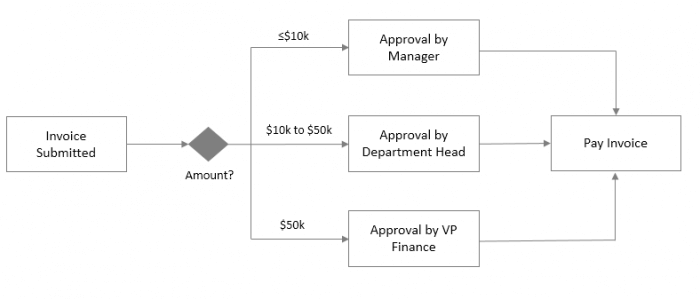What Are Business Rules?
Business process automation is often a core initiative in organizations’ digital transformation strategies. As part of those efforts, organizations should take advantage of business rule-modeling capabilities and refrain from directly hard-coding business rules as part of their implementation designs.
Business rules can apply to many aspects of an organization and can be expressed in a variety of ways. In general, business rules define specific instructions or constraints on how certain day-to-day actions should be performed.
For example, business rules can include:
- A decision-making approval structure for invoice processing where only certain managers can sign off on invoices totaling a specific amount
- Calculations in which a formula may be used to calculate revenue or expenses
- Policies where an organization requires its employees to work with a preferred list of vendors
When business rules are designed separately from process implementations, they provide a powerful and flexible approach to help organizations move more quickly in meeting their goals and better respond to changing business needs.
How Business Rules Support Process Automation
In practice, business rules may not always be formally documented, but as many organizations undergo digital transformation, defining and automating business rules can help organizations more effectively reach their goals.
Traditional automation methods often involve hard-coding business rules directly within process workflows. However, these rigid process designs may restrict an organization’s ability to quickly make updates. Given that business logic is likely to change over time, it can be disruptive to find all the affected implementations and make time-sensitive updates to custom code or process designs, especially if multiple processes call on the same rules. There is also the potential risk of the same rule being implemented slightly differently, leading to inconsistent outcomes. Furthermore, how quickly design changes can be made often depends on the availability of technical staff or the IT department.
To help organizations remain responsive and agile, some process automation software offers the capability to model business rules independently from automated processes. This allows organizations to separate their business logic from their process logic. In other words, staff do not need to go one-by-one through each process and change each implementation of the rule manually.
Furthermore, business rules are made available in an easy-to-read format for the domain experts who manage the company’s business policies and likely do not having programming skills. This allows them to make updates to processes without involving developers or impacting the core infrastructure in place. With this approach, organizations are effectively able to maintain flexibility while saving valuable staff time spent updating organizational policies.
Common Types of Business Rules
To account for different types of policies and decisions, business rules can be modeled in multiple ways. Two common types of business rules are formula rules and decision table rules.
A formula rule allows employees to maintain calculations in a no-code format, similar to creating formulas in Microsoft Excel. Once a formula is defined, it can be reused as appropriate in multiple process designs. If the formula needs to be updated, only the formula itself needs to be changed without requiring an end user to manipulate code or individually adjust each applicable process. Many standard formulas are already built into the software, such as determining an average, sum, date, and maximum, among many others.
A decision table rule is a powerful feature that lets non-developers represent related conditional decisions or “if-then” logic in a concise manner as a spreadsheet style-table. Decision tables use columns as the conditions, while rows specify the appropriate outcomes. Approvals, application acceptance criteria, and loan eligibility checks are all general examples where decision tables can be applied and owned by the domain experts themselves.
In traditional approaches, these decisions can be hard-coded directly as part of process designs, leading to complex implementations that require developers to make manual updates as they arise. When complex logic is modeled as a table, it provides a much more relatable and visual format that is easier to maintain for both business and IT.
How Business Rules Simplify Automation Design
Consider a generic invoice approval flow as an example business process that an organization can automate. These types of processes can involve complex approval structures encompassing multiple cost centers and decision-makers that vary based on the type of invoice and invoice amounts.
When changes need to be made, it can be time-consuming to make updates if the business logic is implemented directly within the processes themselves. The diagram below represents a simplified design for how an invoice approval process may be implemented.

In practice, the conditional decision logic that determines which manager level should approve an invoice of a certain amount can be hard-coded into the process design. However, if a manager ends up changing roles or the invoice threshold amount needs to be adjusted, this would require a technical employee to manually make the changes directly within the process implementation. This is not a trivial task—especially with complex systems where valuable technical staff could better utilize their talents on higher value projects.
Instead of building out the approval logic structure directly within the automated process, the decision logic can be modeled separately as a business rule, simplifying design and increasing flexibility. In this example, the decision logic can be best modeled as a decision table as shown below.

Based on the invoice value input amount, the decision table can automatically determine the appropriate approving party as the output. The output is made available for the underlying workflow design to move forward with.
This decision table provides an accessible format for a domain expert to easily update, test, and deploy as necessary without disrupting the underlying process implementation or depending on IT to perform updates. With the decision table in place, the above process implementation can now be simplified to the below.

As many business processes include complex conditional logic, incorporating decision tables can greatly simplify process designs. Furthermore, the management of decision tables can be made available to the business, while IT or systems admins could be more involved with the advanced aspects of the solution design.
Benefits of Business Rules
Using business rules as part of a process automation software platform provides a number of advantages. These include:
- Efficiency: Domain experts can centrally define and implement changes to policy logic themselves. Updates can be immediately applied to relevant processes without waiting for a technical resource to become available.
- Increased productivity: With employees spending less time on tedious updates, they can focus more on value-add activities.
- Consistency: If a business rule is updated, all processes referencing that rule will be changed accordingly.
- Improved compliance: Organizations can effectively show how certain outcomes were reached when business rules are explicitly defined and decisions tracked.
- Reduced Complexity: Business rules are represented in simplified formats that do not require coding skills, such as tables and diagrams, and can be re-used as necessary on appropriate processes.
With the many advantages business rules provide, they should be an important part of an organizations’ business process automation strategies. By placing business rules front and center in an understandable format, business and IT can better align on moving the organization forward.
Business rules enable gains in productivity, efficiency, and agility. As part of a robust process automation platform, they help organizations become more future-proof. For three decades, Laserfiche’s process automation and content services capabilities have helped enable digital transformation for organizations worldwide. Business rules further expand Laserfiche’s powerful feature set, where the domain experts are empowered to implement policy and rule updates on their own, while consistency and compliance remains intact across business operations.
If you want to get started quickly with business rules, be sure to check out the Laserfiche Solution Marketplace, with pre-built workflows for accounts payable, expense reimubursements and more!
To learn more about how business process automation tools can improve productivity and efficiency for your business, read our Process Automation Buyer’s Guide.


